The demand for quick results has led many in the HVAC industry to use single number evaluation methods, such as IPLV (integrated part load value) as a substitute for executing a complete hour-by-hour modelling analysis.
For years, the HVAC industry has struggled to find easier ways to quickly evaluate the performance of central chiller plants. With accelerating pressure to increase design productivity, the desire grows stronger for a quick, simple and accurate evaluation tool to analyse chiller plant performance. This demand for quick results has led many in the HVAC industry to use single number evaluation methods, such as IPLV (integrated part load value) as a substitute for executing a complete hour-by-hour modelling analysis.
Using less comprehensive evaluations is enticing and seems logical. IPLV was created by the Air Conditioning, Heating, and Refrigeration Institute (AHRI) and often is promoted by some manufacturers as the method to analyse chiller performance. However, as acknowledged by AHRI (and described later), IPLV or NPLV (non-standard part load value) does not accurately represent a chiller plant’s operating characteristics. Decisions based on this incomplete data often result in poor predictions of equipment energy use, so it is important to use accurate energy analysis tools to ensure optimal solutions economically and environmentally.
What’s wrong with using an IPLV?
First, it is important to recognise that AHRI’s IPLV and NPLV evaluation methods were created to help compare the unloading characteristics of similar chillers — not to infer economic savings. Since many chillers operate much of their time at conditions other than full load, an IPLV is an important tool in determining how well a chiller is able to unload. However, to ensure sound purchasing, design, and energy saving decisions are made, a full system analysis must be performed.
Let’s run through some facts of the IPLV formula.
Fact 1: IPLV evaluates a single chiller application only. Appendix D, D2.1 of AHRI Standard 550/590 states:
“The [IPLV] equation was derived to provide a representation of the average part-load efficiency for a single chiller only.”1 It is not applicable for multiple-chiller installations.
Current estimates2,3 suggest that more than 90% of central water-cooled chilled water plants are multiple-chiller installations, the most common being comprised of two chillers.
Fact 2: IPLV uses only four operating points with weighting factors intended to indicate the percentage of time a single chiller, following an averaged load profile, will operate at different loads and with assumed entering condenser water temperature.
AHRI definition of IPLV4
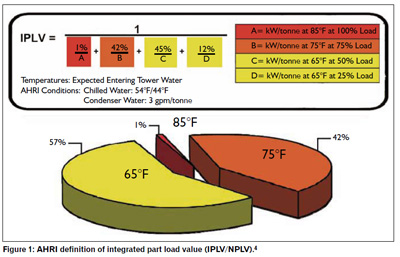 Figure 1 , indicates how the different weighting factors are used to calculate the IPLV value. Points A, B, C and D are the kW/tonne performance levels at each of the four loading points. Note that the calculation assumes that only 1% of the chiller operation occurs at high loads and high condenser water temperatures.
Figure 1 , indicates how the different weighting factors are used to calculate the IPLV value. Points A, B, C and D are the kW/tonne performance levels at each of the four loading points. Note that the calculation assumes that only 1% of the chiller operation occurs at high loads and high condenser water temperatures.
It’s often argued that chillers simply do not operate at 100% load; therefore, the full loadrating doesn’t matter. In a world where most chillers are oversized, this may be true at design conditions in single chiller applications.
While some chiller plant sequence of operations turn a second chiller on before the first chiller ever reaches full peak load, many comfort cooling applications do not start another chiller until the system supply-water temperature rises above the desired setpoint for a defined period of time. In such cases, chillers do operate at full load. For this discussion, it is assumed that chillers do not operate the majority of their time fully loaded. Does this validate the IPLV/NPLV choice of 1%? Let’s take a look.
Figure 2 illustrates that a chiller plant with three chillers has a very different load profile. Another industry rating system, seasonal energy efficiency ratio (SEER), uses a larger number of operating points to more fully represent the entire range of equipment operation. Unfortunately, SEER is not used for large chiller rating, and the current rating system is limited to four distinct operating points.
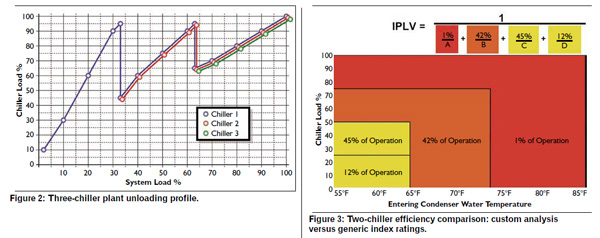
Specifically, the IPLV/NPLV calculation assumes that 57% of the operating hours of the chiller are at 50% load or less. Figure 2 shows that only one chiller will run at less than 50% load, and this occurs only when the entire chiller plant is unloaded to less than 16.7% capacity. This point alone demonstrates that the IPLV formula is not an accurate evaluation tool to use for central chiller plant performance.
Now, some control sequences will let all operating chillers unload further than 50% before shutting them off to avoid the need to turn that chiller back on if the load increases slightly. (When two chillers are running, both would be allowed to unload to about 45% capacity before turning off Chiller 2. The resulting load on Chiller 1 would require it to operate at 90% capacity.) The specific load profile must be examined to reach a definite conclusion; however, it can be stated that a smaller portion of the chiller’s operating hours will actually occur at full load.
Assumptions on cooling tower temperatures is the key
Figure 3 (above) illustrates how the IPLV/NPLV formula “buckets” the operating criteria. Let’s take a look at the percentage of load versus the entering condenser water temperatures.4,5
The IPLV/NPLV formula assumes a condenser water-relief schedule that results in corresponding chiller relief, or reduction in power, as lowering the condenser water temperature has a dramatic impact on chiller performance. Note that lower temperature tower water is not typically “free.” Specifically, this is due to the additional energy expended at the cooling tower to create lower temperatures entering the condenser (if those temperatures are even possible), as the entering condenser water temperature is limited by the outdoor wet-bulb temperature.
In many climates of the world, the lower range of the condenser water temperatures can never be reached during the cooling season. Further, even when the physics allow low cooling tower return water temperatures to be achieved, the energy required by the tower may increase the overall plant energy consumed. Plant controls should focus on balancing the energy equations such that the chiller plus ancillary equipment minimise the plant’s overall energy consumption, not singularly focusing on one variable.6
More importantly, the assumed reduction of entering condenser water temperature changes coincidently as the load is reduced. The IPLV/NPLV calculation assumes that the chiller plant operates 57% of the time at 65°F (18.3°C) entering condenser water temperature, and only 1% of the time above 75°F (23.9°C) entering condenser water temperature. As stated by the AHRI IPLV definition (Figure 1), all operating points above 75% load and warmer than 75°F (23.9°C) water are assumed to occur only 1% of the time. Said another way, 99% of the time, the chiller will be unloaded to less than 75% load and operate with 75°F (23.9°C) entering condenser water or colder.
Fact 3: IPLV does not take variable-speed drives into consideration. Unfortunately, the values and methodologies originally intended to rate chillers did not fully consider the application of variable-speed drives, at least on centrifugal designs.
Centrifugal compressors are dynamic compressors making them more dependent on lift reduction in lieu of load reduction. From a physics perspective, these compressors raise the pressure of the refrigerant by imparting velocity, or dynamic energy, using a rotating impeller, and convert it to pressure energy. In contrast, screw or scroll compressors are positive-displacement compressors where two mechanical pieces mesh together to trap refrigerant vapour, and reduce the volume of the refrigerant to a discharge point. This difference between dynamic and positive displacement compression leads to considerable difference in response to variations in speed (or hertz) that can be imparted by a variable-speed drive. By changing the speed of a positive displacement compressor, the amount of work, or load, handled is varied.
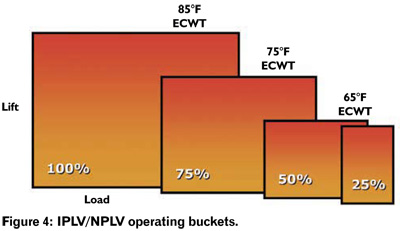 Conversely, this impact is not seen with a centrifugal chiller. In trying to simply state the impact for a centrifugal chiller, reducing condenser water temperatures or increasing chilled water supply temperature will reduce the lift, or work, the compressor has to provide. It does not reduce the amount of load or refrigerant compression required. Thus, the dominant driver of any hertz variation, or speed change, of the compressor is the amount of lift the compressor can stably handle, not the load.
Conversely, this impact is not seen with a centrifugal chiller. In trying to simply state the impact for a centrifugal chiller, reducing condenser water temperatures or increasing chilled water supply temperature will reduce the lift, or work, the compressor has to provide. It does not reduce the amount of load or refrigerant compression required. Thus, the dominant driver of any hertz variation, or speed change, of the compressor is the amount of lift the compressor can stably handle, not the load.
Recall that IPLV/NPLV is dictated by four distinct operating buckets incorporating simultaneous load and lift reduction (Figure 4). So, while variable-speed drives can offer significant savings in the right application for centrifugal chillers, they give the perception of efficiency gains when the IPLV/NPLV formula is applied — a recipe for selling more drives, and not necessarily offering real energy savings.
IPLV/NPLV operating buckets
Fact 4: The intent of IPLV is to compare unloading characteristics, not to infer economic savings. Appendix D2 of ARI Standard 550/590 states: “It is best to use a comprehensive analysis that reflects the actual weather data, building load characteristics, operational hours, economiser capabilities and energy drawn by auxiliaries such as pumps and cooling towers, when calculating the chiller and system efficiency.”1
A detailed hour-by-hour energy analysis is needed to determine economic savings. Let’s take a look at a detailed analysis and compare it to IPLV. At the outset of this analysis (using TRACE 700), a high degree of importance was placed in offering a global perspective to demonstrate the many varying global climates that impact both the load and lift aspects of the chiller plants serving the building HVAC systems. The cities modelled are shown in Figure 5.
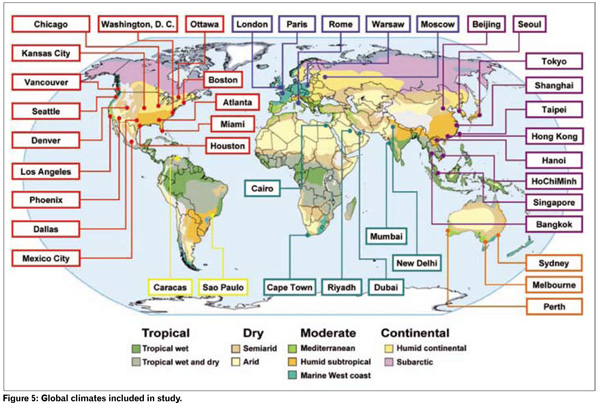
The following are fixed and variable assumptions made for this analysis:
This leaves the weather and resultant loads as variables. Once the detailed hour-by-hour weather-dependent analysis is completed, the corresponding operating points per chiller are plotted on the template outlined in Figure 3. Each operating hour for an entire year is plotted and represented as a point on the graph. With two chillers ready to operate 24 hours a day, 365 days as required, there is potential for 17,520 operating points (8,760 per chiller). Clearly, the number of points varies with climate and cooling needs. The resulting plotted points are, then, totalled and the percentage of operation in each AHRI IPLV/NPLV “bucket” is determined.
An example comparison
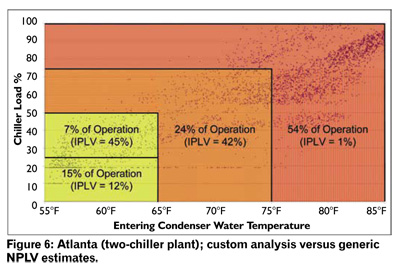 Prudence dictates a close look at an example to demonstrate the tool prior to showing all global geographic regional charts. Examining the chart depicting Atlanta (Figure 6), it quickly becomes evident that the two-chiller plant operation does not align with the values of IPLV/NPLV.
Prudence dictates a close look at an example to demonstrate the tool prior to showing all global geographic regional charts. Examining the chart depicting Atlanta (Figure 6), it quickly becomes evident that the two-chiller plant operation does not align with the values of IPLV/NPLV.
IPLV accounts for 1% of operation above 75% percent load and above 75°F (23.9°C) ECWT. Reviewing Figure 6, we see that this typical application demonstrates 54% of operation with warmer than 75°F (23.9°C) condenser water with loads greater than 75% load.
A global analysis of various climates
The analysis so far has used weather data for climate in Atlanta. It is important to look at locations with different climate profiles. (See Figure 7, for a subset of plotted charts analysed and Table 1 – at the end of this article – for all location included in the analysis.)
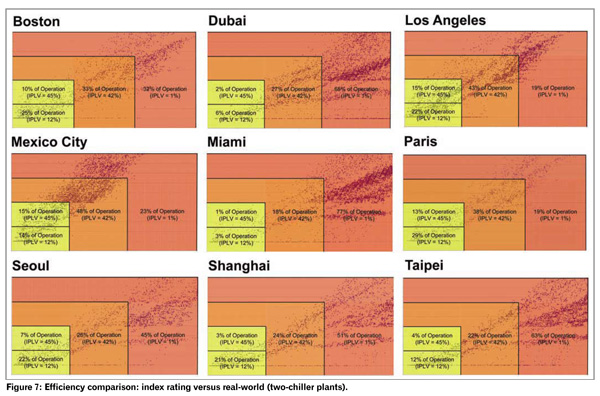
It is clear after reviewing the data from various global locations that by far the most critical performance bucket is the one most understated in the IPLV/NPLV formula: weather. Weather is the most volatile component of the total load over the course of a year.
Other components that contribute significantly to the overall load of the building, such as internal and solar loads, are more consistent throughout the year. Therefore, climate, specifically the wet-bulb temperature, has the greatest impact on the associated condenser water temperatures produced by the cooling tower and the building usage of the outside air economiser. Coincidently, without a reduction in condenser water temperatures, the compressor lift is not significantly reduced, which hinders the centrifugal chiller’s ability to leverage the variable-speed drive investment.
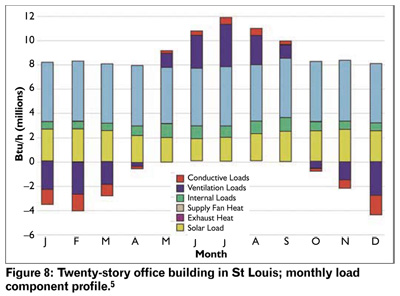 To illustrate the contribution of different types of loads on a building and to supplement the discussion, Figure 8, depicts the load contribution and profile for a typical moderate-climate, two-chiller commercial office space.
To illustrate the contribution of different types of loads on a building and to supplement the discussion, Figure 8, depicts the load contribution and profile for a typical moderate-climate, two-chiller commercial office space.
Clearly, the internal and solar loads are relatively consistent throughout the year; however, the weather load shifts dramatically. This illustrates precisely why the investment in programmes that rely on full hour-by-hour location-dependent weather is critical to making accurate conclusions. Conversely, it highlights why bin data will lead to the wrong conclusions, as weather is only representative of a small percentage of the total building load, and does not address the large impact on cooling tower performance.
The global analysis figures show how the AHRI loading points misrepresent a typical chiller plant. Note that the operation of the chiller consumes the most energy, establishing demand charges with the highest kW. The IPLV/NPLV formula assumes that only 1% of the chiller operation occurs at high loads, and high condenser water temperatures. In reality, the global average for this bucket is 47.9% of a two-chiller plant’s operating hours over the course of a year — that is nearly half.
The impact of chiller count
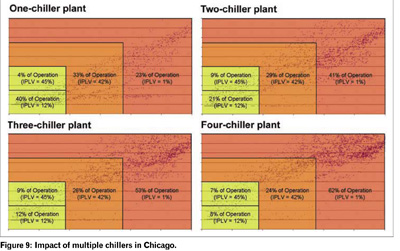 In this analysis we also focused on multiple chillers versus location-dependent weather and yielded the same conclusion: the highest load and lift bucket remains the most prominent. Figure 9 shows a variation in the number of chillers in Chicago where condenser water relief is certainly attainable, as the vastly contrasting seasons offer many shoulder months of operational hours with cool temperatures. Again, each plot point represents one hour of chiller operation during the year.
In this analysis we also focused on multiple chillers versus location-dependent weather and yielded the same conclusion: the highest load and lift bucket remains the most prominent. Figure 9 shows a variation in the number of chillers in Chicago where condenser water relief is certainly attainable, as the vastly contrasting seasons offer many shoulder months of operational hours with cool temperatures. Again, each plot point represents one hour of chiller operation during the year.
Figure 9, shows that as the number of chillers in a plant grows, so does the importance of the higher bucket. Even a single chiller plant analysis in Chicago where relief is imminent, the number does not even get close to 1%.
Table 2, provides a summary of the multiple chillers plants for the geographic region. Once again, it clearly shows that a holistic approach to selecting chillers should be standard practice, rather than reliance on a single number.
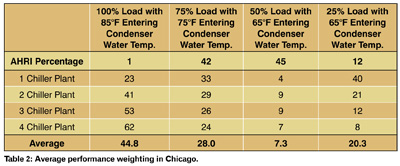 In this particular analysis, the chiller plant is a solid candidate for a single variable-frequency drive on a single centrifugal chiller, as it has both a significant number of hours at low operating tons (part load) and low condenser water temperatures (part lift). Conversely, as chillers are added, the plant becomes increasingly less suitable as a candidate for variable-frequency drives. A better option might be to invest in more heat exchanger surface to maximise operational performance at high loads and high condenser water temperatures, or possibly provide a single drive on only one chiller for the low-load, low-lift conditions. Bottom line: the right design can be speculative, but a detailed analysis is the only prudent method to determine the most economic and energy-efficient plant.
In this particular analysis, the chiller plant is a solid candidate for a single variable-frequency drive on a single centrifugal chiller, as it has both a significant number of hours at low operating tons (part load) and low condenser water temperatures (part lift). Conversely, as chillers are added, the plant becomes increasingly less suitable as a candidate for variable-frequency drives. A better option might be to invest in more heat exchanger surface to maximise operational performance at high loads and high condenser water temperatures, or possibly provide a single drive on only one chiller for the low-load, low-lift conditions. Bottom line: the right design can be speculative, but a detailed analysis is the only prudent method to determine the most economic and energy-efficient plant.
Conclusions
IPLV/NPLV should not be used as an efficiency standard. When looking at the real operating points of a chiller, it becomes increasingly obvious that high-load operating points are extremely important. It also becomes obvious that using the AHRI 550/590 Standard can lead to a misrepresentation of where two chillers really operate. IPLV/NPLV methodology makes sense when determining minimum efficiency requirements, such as in the Standard 90.1 or IECC efficiency standards (Figure 10, at the end of this article). These standards require the user to meet both full-load and a part-load performance measures. Good full-load performance is critical to minimise peak energy consumption, which impacts building owners around the world, as these peak charges establish demand charges and ratchets within utility bill clauses. Good part-load performance is critical to ensure a chiller will properly reduce energy consumption as the lift and load is reduced.
The bottom line is that you need to do the right thing. Using single number evaluations cannot accurately represent a chiller’s energy use in a system. It also cannot predict the savings that can be associated with the additional investment of a variable-speed drive, and can in no way be indicative of a financial payback. Perhaps if a simplified “IPLV-type” methodology is required, using the weighting guidelines, found in Table 1, or generating a customer part-load value, may provide a more realistic guideline for predicting chiller performance.
Meanwhile, today’s marketplace offers a myriad of computer simulation programs with the capability of modelling a surprising number of critical variables, including hour-by-hour energy analysis, variable electrical rates, diverse building types and operating profiles, chiller plants and performance characteristics such as variable-speed drives and high-efficiency chillers. Additionally, drastic improvements in user interfaces of available simulation programs offer operator effectiveness and efficiency shortening start-to-end completion times, never before possible, eliminating the need for short cuts.
The desire to find the “easy” answer is understandable. However, as Standard 550/590, Appendix D, suggests, careful analysis is the only real means to accurately determine a building’s energy usage with corresponding economic impacts to determine fiscally responsible conclusions. The bottom line is that there is no easy answer. It’s our responsibility as an industry to use the tools and technology available to practice due diligence and offer our clients viable, sustainable and proven solutions.
References:
|
By W Ryan Geister, Member ASHRAE, and Mike Thompson, Associate Member ASHRAE About the Authors W. Ryan Geister is global product manager, Trane Centrifugal Chillers – Climate Solutions, Ingersoll-Rand in LaCrosse, Wis. Mike Thompson is director, Trane Environmental Affairs – Climate Solutions, Ingersoll-Rand in College Station, Texas. |
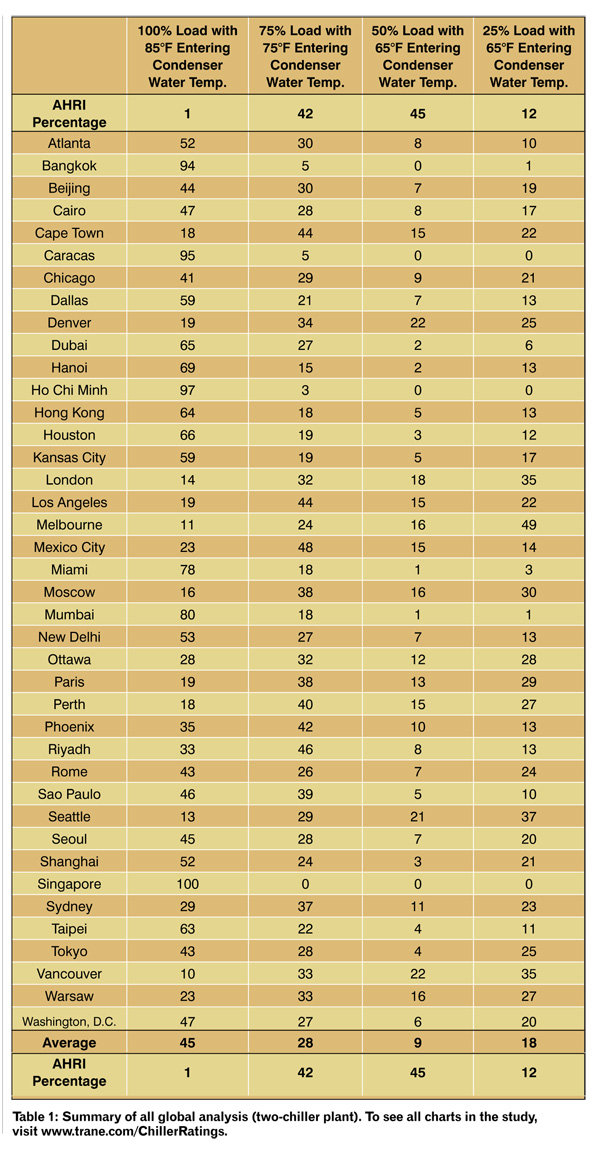
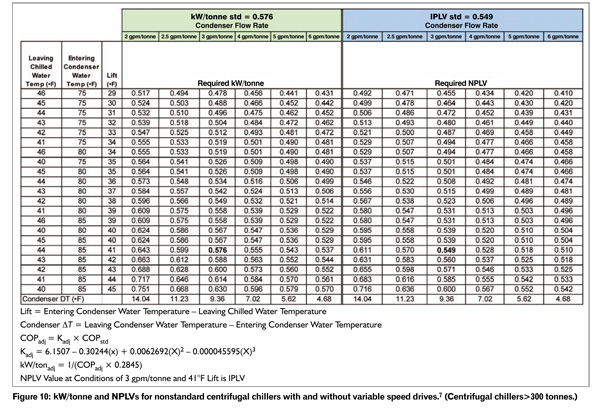
Copyright © 2006-2025 - CPI Industry. All rights reserved.